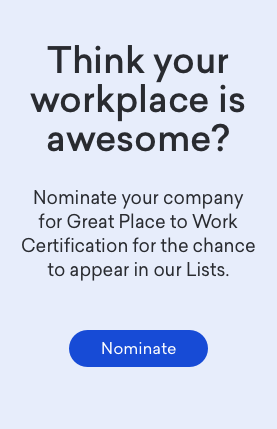Creating Coherence in Your Work Experience
Fall is a season where we experience big transition, and while it is not yet the end of the calendar year, in many ways it can feel like a new beginning. In our organizations we are often coming together to plan for the new year, setting budgets and establishing our strategies. Some organizations host large consumer conferences in the fall, allowing them to spread their new ideas and launch products at this energizing time. Many organizations are also wrapping up sales and budget cycles to begin their new fiscal year.
While we might not change the calendar yet, fall is a significant time of change that necessitates alignment, both in and across teams, as well as in ourselves as individuals. At Great Place to Work, alignment is the first step on our Great Place to Work® Roadmap Process that we use as the foundation for our culture change consulting services. After years of working with and researching great workplaces we know that strong alignment at all levels of the organization is key to successful change and growth.
Aligned and Adaptive Teams
During times of change and reflection it is particularly important that leaders are in tune with all elements of their business reality and bring that awareness to their teams. When organizations operate in a low-trust environment employees are more likely to operate at a lower state of mind. There are many ways of describing this reactive low-state, which author and neuroscience expert Christine Comaford calls the “critter state”. In this state people are driven by fear and a desire to protect themselves. In teams at work this could show up as a lack of collaboration, low levels of engagement, or a tendency to focus on problems that are not strategic or relevant. Particularly during important times of planning leaders need to be aware of these tendencies and pull their teams to a higher level of thinking. In her book Smart Tribes: How Teams Become Brilliant Together, Comaford recommends five approaches to help elevate teams to what she calls a “smart state”:
- Focus: Be aware of what is most important and allow other things to take a backseat
- Clarity: Be aware of why you are doing certain things and not others
- Accountability: Have clear expectations, ownership, rewards and consequences
- Influence: Be able to understand, empower and motivate your people
- Sustained Results: Have energy to enjoy your work and not experience burnout
A Tool for Individual Awareness
While all of these tools are excellent for supporting teams, it is challenging for leaders to implement these approaches in their teams if they cannot do so also within themselves. Self-awareness has long been an important trait of successful leaders, a belief which has been bolstered in the last several years by the success of mindfulness training and neuroscience-based approaches to leadership and interpersonal interactions. There is little doubt in the scientific community that increased self-awareness facilitates better leadership and interpersonal connection, allowing individual leaders to truly move their teams to that desired “smart state”.
There are now seemingly endless ways to bringing awareness to your practice as a leader, but one that encompasses many aspects of both neuroscience and mindfulness, is Dr. Dan Siegel’s mindsight approach. At the heart of his approach is the concept of integration, which entails the linking of multiple different aspects, of either an individual or group.
In an individual leader, integration involves the connecting of mental and physical activities such as thoughts, feelings, sensations, or logic, into one complete experience. When leaders are highly integrated within themselves they are aware of all of their internal responses and activities as part of a whole self. This kind of integration creates optimal performance as it enables flexibility, adaptability and creativity. The mindsight approach encourages this way of being by refocusing attention to change the way your brain responds to stimuli, internally and externally. Leaders functioning in this manner are less reactive and more thoughtful. They are more attuned to the ways their teams work, and can understand and empathize with others more effectively. How could we expect leaders to move their teams into a “smart state” of being, without being there themselves?
The Advantage of Alignment
Whether we call it integration, coherence, or alignment, all these concepts point to the same experience – one of stability and harmony, where things come together in a unified way. At Great Place to Work we see alignment, particularly among senior leaders, as a key differentiator in what makes a great workplace. Alignment creates consistency of decision and action. From top to bottom organizations who are clear on what they do, and how and why they do it, are more effective and are able to build stronger cultures.
As we move through this season of change and our actions and decisions shape the year to come, it is important that we think critically about this concept of alignment and integration. As a leader, are you aligned within yourself? Can you explain your actions and decisions in a coherent and unified manner? And are your teams aligned within themselves? Are you all rowing in the same direction with the same understanding of one another and the objectives of the group? If not, it might be time to consider using a new approach to develop the kind of awareness you need to lead an aligned and committed team into the new year.
Hannah Jones is a Consultant at Great Place to Work®.
Click here to learn more about how Great Place to Work can help align your culture to your business outcomes.














